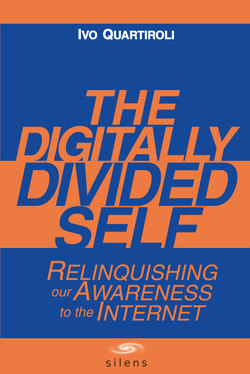Читать книгу The Digitally Divided Self: Relinquishing our Awareness to the Internet - Ivo Ph.D. Quartiroli - Страница 24
На сайте Литреса книга снята с продажи.
Binary and Inner Duality
ОглавлениеTechnology has continued developing, bringing us to the contemporary digital technologies. The core of every computer and electronic gadget is made up of 0s and 1s, binary sequences which represent the world as encoded texts, images and videos. The inner structure of a tool reflects the ways it is used, just as the molecular structure of a material reflects its macro-features like density, texture and resistance.
Splitting, distinguishing, choosing, and repeating are the main modalities of the Boolean logic that is behind binary technology. In the computer programming languages used to develop software, one of the main logical structures is the “if-then-else” construct (“if A, then B; if else than A, then C”) that allows statements to operate on choices and dualities.
The dualistic binary modality of functioning is typical of the rational thinking mind – and the computer extends such cognitive modalities. The basic structures of the mind are also born through the first dualistic event, when a child begins to split pleasurable-good-love-warm-care sensations from unpleasurable-bad-fear-alone-hunger ones. The first mental concepts are born by splitting our experiences. The infant does not yet have any concept or way to understand what is happening around him, but he already has the capacity to perceive and sense.
Within the undifferentiated world of the infant, the first primitive dual mental structures form, closely tied to his physiology – as in feeling good or bad. Later, this dualistic attitude will create more sophisticated mental structures, like concepts and ideas with further refined differences.
In Tibetan Buddhism, the nature of the mind is understood as dualistic. Its job is to reinforce our separation from anything and anybody else. “That which possesses a sense of duality – which grasps or rejects something external – that is mind. Fundamentally, it is that which can associate with an ‘other’ – with any ‘something’ that is perceived as different from the perceiver. That is the definition of mind” (Trungpa, 1991, p. 23).
Our mind is not just a mechanical logic-oriented dualistic tool’ – we can feel emotions too. Though thinking and feeling are usually seen as different entities, mind, in the Tibetan Buddhist tradition, includes emotions and sensations. Even the most appealing feelings still pertain to the mind. Emotions support the workings of the mind. “Daydreaming and discursive thoughts are not enough,” Chogyam Trungpa explains. “Those alone would be too boring. The dualistic trick would wear too thin. So we tend to create waves of emotions which go up and down: passion, aggression, ignorance, pride – all kinds of emotions” (p. 23).
Emotions support the mind to keep at its separating dualistic task. Even the computer has evolved beyond a tool that merely encourages a dry, rational attitude for our minds. Now it feeds our emotions through music, videos, sex, and social connections.
